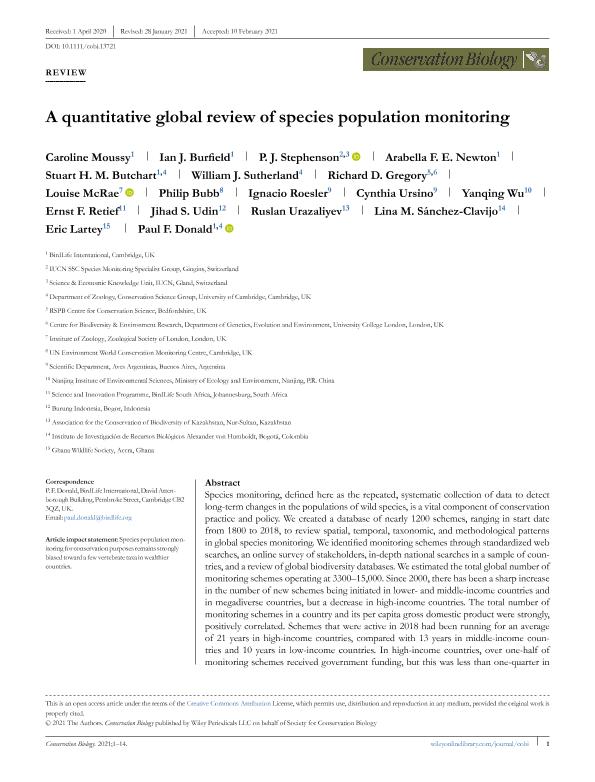Artículo
A quantitative global review of species population monitoring
Moussy, Caroline; Burfield, Ian J.; Stephenson, P. J.; Newton, Arabella F. E.; Butchart, Stuart H. M.; Sutherland, William J.; Gregory, Richard D.; McRae, Louise; Bubb, Philip; Roesler, Carlos Ignacio ; Ursino, Cynthia Alejandra
; Ursino, Cynthia Alejandra ; Wu, Yanqing; Retief, Ernst F.; Udin, Jihad S.; Urazaliyev, Ruslan; Sánchez Clavijo, Lina M.; Lartey, Eric; Donald, Paul F.
; Wu, Yanqing; Retief, Ernst F.; Udin, Jihad S.; Urazaliyev, Ruslan; Sánchez Clavijo, Lina M.; Lartey, Eric; Donald, Paul F.
 ; Ursino, Cynthia Alejandra
; Ursino, Cynthia Alejandra ; Wu, Yanqing; Retief, Ernst F.; Udin, Jihad S.; Urazaliyev, Ruslan; Sánchez Clavijo, Lina M.; Lartey, Eric; Donald, Paul F.
; Wu, Yanqing; Retief, Ernst F.; Udin, Jihad S.; Urazaliyev, Ruslan; Sánchez Clavijo, Lina M.; Lartey, Eric; Donald, Paul F.
Fecha de publicación:
02/2022
Editorial:
Wiley Blackwell Publishing, Inc
Revista:
Conservation Biology
ISSN:
0888-8892
Idioma:
Inglés
Tipo de recurso:
Artículo publicado
Clasificación temática:
Resumen
Species monitoring, defined here as the repeated, systematic collection of data to detect long-term changes in the populations of wild species, is a vital component of conservation practice and policy. We created a database of nearly 1200 schemes, ranging in start date from 1800 to 2018, to review spatial, temporal, taxonomic, and methodological patterns in global species monitoring. We identified monitoring schemes through standardized web searches, an online survey of stakeholders, in-depth national searches in a sample of countries, and a review of global biodiversity databases. We estimated the total global number of monitoring schemes operating at 3300–15,000. Since 2000, there has been a sharp increase in the number of new schemes being initiated in lower- and middle-income countries and in megadiverse countries, but a decrease in high-income countries. The total number of monitoring schemes in a country and its per capita gross domestic product were strongly, positively correlated. Schemes that were active in 2018 had been running for an average of 21 years in high-income countries, compared with 13 years in middle-income countries and 10 years in low-income countries. In high-income countries, over one-half of monitoring schemes received government funding, but this was less than one-quarter in low-income countries. Data collection was undertaken partly or wholly by volunteers in 37% of schemes, and such schemes covered significantly more sites and species than those undertaken by professionals alone. Birds were by far the most widely monitored taxonomic group, accounting for around half of all schemes, but this bias declined over time. Monitoring in most taxonomic groups remains sparse and uncoordinated, and most of the data generated are elusive and unlikely to feed into wider biodiversity conservation processes. These shortcomings could be addressed by, for example, creating an open global meta-database of biodiversity monitoring schemes and enhancing capacity for species monitoring in countries with high biodiversity. Article impact statement: Species population monitoring for conservation purposes remains strongly biased toward a few vertebrate taxa in wealthier countries.
Archivos asociados
Licencia
Identificadores
Colecciones
Articulos(CCT - PATAGONIA NORTE)
Articulos de CTRO.CIENTIFICO TECNOL.CONICET - PATAGONIA NORTE
Articulos de CTRO.CIENTIFICO TECNOL.CONICET - PATAGONIA NORTE
Citación
Moussy, Caroline; Burfield, Ian J.; Stephenson, P. J.; Newton, Arabella F. E.; Butchart, Stuart H. M.; et al.; A quantitative global review of species population monitoring; Wiley Blackwell Publishing, Inc; Conservation Biology; 36; 1; 2-2022; 1-14
Compartir
Altmétricas



